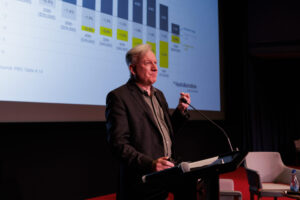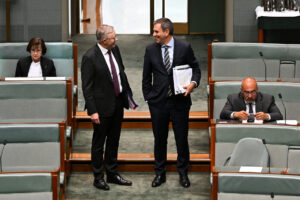by Ebony Bennett
[Originally published on The Canberra Times, 22 April 2019]
Australia is having a huge national debate about taxes and tax reform that’s mostly missing the point. There’s too much focus on costings and not enough analysis of who is getting the biggest slice of pie – here’s a hint: it’s not those struggling to make ends meet.
If Australians are going to make an informed choice, the tax debate must examine not only the costs of the competing policies, but also ask who benefits the most? “If you have a go, you get a go” has been the Prime Minister’s constant refrain, but “getting a go” isn’t the same as “getting a fair go”.
Now, if you believe in trickle-down economics, giving the biggest benefit to the wealthiest Australians is a perfectly reasonable approach. And whether we look at income tax cuts, franking credits or negative gearing and the capital gains tax discount – the same group of people have been “getting a go” and the lion’s share of the benefit: the wealthiest Australians.
Top end tax cuts
The tax cuts aimed at low and middle income earners are basically bipartisan. It is tax cuts for wealthy people where the Coalition and Labor really disagree and where voters face a real choice. The second stage of the Coalition’s income tax cuts are a nightmare for inequality, which overwhelmingly benefit high income earners and make Australia’s income tax system less progressive and will worsen inequality.
The Australia Institute has estimated that the very highest income earners (those earning over $180,000) will receive at least $77 billion from the Coalition’s income tax cuts package. Ministers Mathias Cormann and Simon Birmingham both disputed the $77 billion figure, but neither was able to provide a more precise figure when asked multiple times by David Speers or Patricia Karvelas. This seems odd considering the level of detail the Coalition asked Treasury to compile on Labor’s tax policies.
To be clear, if you’re one of the 427,000 or so people who earn more than $180,000 a year there’s $77 billion coming your way, but if you’re one of the 715,000 or so people who currently can’t find a job and rely on Newstart: nothing.
Peter Costello and John Howard splurged a once-in-a-generation revenue boom on permanent tax cuts that amounted to approximately $170 billion in foregone revenue within seven years of being implemented. Just under half ($71 billion) went to the top 10 per cent of income earners, who got more than the bottom 80 per cent of taxpayers combined. Now the Coalition is set to do it all over again and the same top 10 per cent of income earners will get the lion’s share. Again.
Franking credits tax bonus
Anyone who has arranged their financial affairs in retirement to take advantage of a cash bonus for franking credits is smart. After all, it’s money for nothing – a cash bonus for tax that hasn’t been paid. That’s the current system the Coalition introduced, wants to keep in place and thinks is fair.
Bill Shorten explained cash bonuses for franking credits this way: “… If you are getting a tax credit when you haven’t paid any income tax, this is a gift. It is a gift. It is not immoral, nor is it illegal, but it is a gift. It is a gift lifted from the taxes paid by working-class and middle-class people in Australia today. It is a gift that is eating our Budget”.
The overwhelming majority of recipients of franking credits overall are people earning the highest incomes, people with incomes so high they can certainly afford accountants who can help them rearrange their tax affairs. Indeed, as Robert Gottliebsen said, ‘Only rich people who are stupid will be affected [by closing this tax loophole]’.
Franking credit cash bonuses are eating the Budget. Labor’s estimates suggest its policy abolish these cash bonuses could save the government more than $5 billion each year.
Five billion dollars is a lot of money each year that can’t be spent on anything else once it’s gone. To put it in perspective, the foregone revenue on cashing out excess franking credits could purchase 50 new primary schools, 50 new secondary schools and 3500 teachers, three new regional hospitals, 2500 nurses and 1500 doctors, 200 fire & rescue vehicles and 800 police officers, with a spare $220 million or so left in the kitty to spend funding other essential services.
If franking credit cash bonuses remain in place, some of this money will certainly make its way into the economy as spending, but the top 10% of income earners certainly won’t be pooling their cash bonuses together to build three new regional hospitals, for example.
Negative gearing and capital gains tax discount
Like franking credit cash refunds, many people take advantage of negative gearing and the capital gains tax discount, which together drive up house prices and mainly benefit-you guessed it! – the top 10 per cent of income earners.
ATO data shows there are more property owners running at a loss and claiming negative gearing for their investments (1.3 million) than those who break even or declare a profit (869,000). Those 1.3 million people are perfectly and legally entitled to arrange their finances to ‘get a go’ at these two tax concessions, but when these two tax concessions together drive up the cost of housing and the top 10 per cent of income earners are getting more than half of the benefit – where’s the fair go for the rest of us?
Most of us rely on a salary or wages for our income and we are taxed accordingly. But income from capital gains is taxed differently. That is, someone earning $100,000 from wages or from running a successful business is taxed twice as much as someone earning $100,000 from capital gains from selling assets (except for their primary residence) for more than they had bought them.
Earning an income from capital gains does not require the production of something but instead means holding an asset while its value increases. So, from an economics perspective this is a less useful form of income. Earning an income from your labour means you are producing something. Risking your money in investment means you are producing something. Earning an income from capital gains is far less productive. So why is it taxed at half the rate of income from wages?
Every dollar we forego in tax concessions for someone’s negatively geared investment property (or their six investment properties) is a dollar that can’t be spent on say, increasing the aged pension so that it keeps up with the cost of living.
Tax cuts and concessions have to make sense. They should be targeted wisely to ensure a fair go for everyone. Instead, tax cuts and concessions benefit most the top 10 per cent of Australians who need it least.
Australia is facing some big policy hurdles in future. We have to stop mining, burning and exporting fossil fuels, to name just one huge policy issue we have not yet confronted.
Taxes are the price we pay for civilisation. To paraphrase the Prime Minister, to give everyone a fair go, everyone should pay their fair share.
Ebony Bennett is deputy director of The Australia Institute.
Between the Lines Newsletter
The biggest stories and the best analysis from the team at the Australia Institute, delivered to your inbox every fortnight.
You might also like
Stage 3 Better – Revenue Summit 2023
Presented to the Australia Institute’s Revenue Summit 2023, Greg Jericho’s address, “Stage 3 Better” outlines an exciting opportunity for the government to gain electoral ground and deliver better, fairer tax cuts for more Australians.
Richard Denniss: National Press Club Address
On Wednesday, 31 January 2024, Richard Denniss and Allegra Spender MP addressed the National Press Club for a debate on the Stage 3 tax reforms. **Check against delivery** [See below for transcripts] Tax is good. Tax is an investment in our society and the highest taxed countries in the world also happen to be the
RN Breakfast: Redesigning the Stage 3 Tax Cuts
Richard Denniss joins ABC RN Breakfast with Patricia Karvelas to discuss redesigning the Stage 3 tax cuts.


